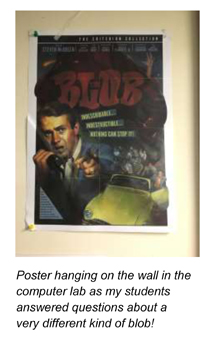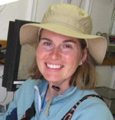Reflections from a teacher: Engaging Students in Ocean Tracks
“This week in class, you are going to be doing ‘college level’ work.” My high school students in my marine biology course stared back at me with their eyes wide, but I didn’t hear the groans that I was expecting. Instead, did I detect some excitement that the bar would be raised?
I had made the decision to try something new with the students in my high school marine biology class at Souhegan High School in Amherst, New Hampshire. Over the last four years, I have used the Ocean Tracks interface and curriculum modules extensively to help students learn about topics such as the adaptations of ocean animals, the marine food web, and human impact on the ocean. What I love about using Ocean Tracks is that students are naturally curious about the habits of animals like white sharks and elephant seals, and Ocean Tracks presents a perfect opportunity to have students engage in an authentic data set. While learning important marine biology content, Ocean Tracks helps students to further develop data skills, such as decoding and describing data patterns and supporting claims with data-based evidence.
In the Ocean Tracks curriculum, students are asked to use data to build an argument using the interface’s variety of data sources to answer a guiding question. In my class, we were finishing up a unit on oceanography, where we had explored everything from thermohaline circulation to sea floor mapping. Next, I wanted to explore the guiding question of “How do oceanographic features affect productivity in the ocean?”
In past years, I had used the Ocean Tracks module from the high school curriculum called “Prey Maps.” Because the Ocean Tracks interface includes the tracks of a variety of marine predators, while also including oceanographic features such as SST, bathymetry and chlorophyll concentration maps, it is the perfect tool to help my students answer the guiding question. During that module, students would take measurements from elephant seal tracks and chlorophyll concentration maps and hypothesize about where they thought the seals were foraging. One of the locations that students marked as a feeding area is the North Pacific Transition Zone, which is where cold, nutrient rich waters from the north and nutrient poor, warmer water from the south meet in the middle of the North Pacific. As a class, we would then discuss why this particular area is so heavily utilized by a variety of ocean predators. Since my students were just finishing up an oceanography unit, I wanted to alter the “Prey Maps” module a bit to front load the oceanography content that explains why certain feeding locations are popular with the elephant seals. But as I started to make some of those revisions, I realized the background research I planned for students to conduct was similar to the research college students completed during the pilot of “What is UP with the California Coast?,” part of the Ocean Tracks College Edition (OTCE) curriculum. I started to wonder, how would my high school students do if I asked them to complete the more challenging module?
Prior to the start of this Ocean Tracks module, our class had just finished a variety of hands on activities in class. Students had looked at the effect of density on the movement of water during some lab work and studied plankton characteristics and adaptations by building their own floating plankton. The timing was right for the students to work on something that was more computer-based and data-oriented. Would they rise to the challenge or would they balk at the expectation of doing more challenging work than the marine biology students before them?
When I explained that the OTCE modules had been written with college students in mind, students seemed intrigued. One student asked, “Well, what makes this harder than what we would have done?” I explained that the college curriculum had been written with the thinking that the students would mostly be working independently on the assignment. “But as we tackle this module with our class, we are going to incorporate more group work so that you can help each other out by sharing you r ideas and to help the work go a bit faster.”
r ideas and to help the work go a bit faster.”
“Alright, so are you ready to begin?” The students nodded in agreement and got to work. During their first work period, they did mostly background research on the cause of upwellings. The room was buzzing as students worked between their “notebook” that they had created using Google Slides (a place for them to record their answers and screenshots of the Ocean Tracks interface), the module itself, and the Ocean Tracks library.
They conferred with each other in whispering voices, “Have you ever heard of ‘the blob’?” in response to the Engage question, “What have you heard about the warm “blob” in the Pacific Ocean?” A frequent question that students had for me was, “But Julianne, is it really OK if we say we have never heard of ‘the blob’?” And some astute students were so excited when they noticed that hanging on the wall in our computer lab was a movie poster for “The Blob.” What a coincidence! They also had a few questions for each other and for me about the location of information on upwellings and the California current in the Ocean Tracks library.
For students that sometimes have trouble sustaining their focus for long periods of time, especially when it comes to doing research, I was really impressed as they worked on the OTCE module. It illustrated the fact that with increased expectations students will be motivated to rise to the challenge.
But the key part of this is to make sure that there are supports in place to help students feel successful when trying to get to that next level. Students were motivated to work harder because they felt the confidence I had in them. They knew that I thought they were capable of tackling the more challenging curriculum because of the knowledge and the skill sets that we have been building in class. They also knew that I would be there to help them when they had questions and also to push them further. This was a great reminder, that even in my class that represents a heterogenous mix of students from different grade levels and different abilities, students are hungry for a challenge. Students are particularly receptive if the conditions are set for them to feel safe, there is a class culture where it is OK if they struggle a bit, and some accommodations are made to help students achieve at this higher level.
The students were off to a great start with this project! Their enthusiasm as they started this module was a testament to the engaging nature of the Ocean Tracks data and curriculum module itself, and the impact of giving students a challenging task that motivates them to want to rise to the challenge. I am excited to see the work they are going to produce!
- jmueller-northcott's blog
- Log in to post comments



 Julianne served on the Advisory Board for the Oceans of Data project, which produced Visualizing Oceans of Data: Educational Interface Design, and has worked for ODI from early conceptualization of Ocean Tracks to the present, developing curriculum modules for both high school and college students. She teaches biology at Souhegan High School in Amherst, NH, and has been using Ocean Tracks to teach concepts in ecology and marine biology and to develop her students’ skills in working with complex, authentic scientific data sets for four years.
Julianne served on the Advisory Board for the Oceans of Data project, which produced Visualizing Oceans of Data: Educational Interface Design, and has worked for ODI from early conceptualization of Ocean Tracks to the present, developing curriculum modules for both high school and college students. She teaches biology at Souhegan High School in Amherst, NH, and has been using Ocean Tracks to teach concepts in ecology and marine biology and to develop her students’ skills in working with complex, authentic scientific data sets for four years.